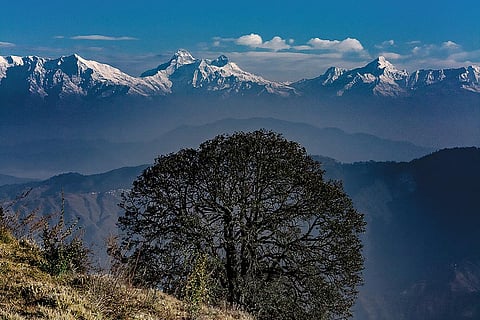
- Destinations
- Experiences
- Stay
- What's new
- Editor’s Picks
- Responsible Tourism
- CampaignsCampaigns
- Subscribe

Whether you’re a rookie traveller or a seasoned explorer, chances are you haven’t escaped the pull of advertisements and social media posts on trekking in the Himalayas. With millions of tourists arriving in the Indian Himalayan Region (IHR), tour operators and hospitality businesses have their hands full with customers looking to get the most bang for their buck. However, the glossy videos and posters usually skip the mounting waste crisis in the Himalayas, and the rapid infrastructural development currently underway to facilitate the transportation of military personnel and tourists. These activities are exacerbating climate pressures in the region, now characterised by retreating glaciers, heavy rainfall and erratic snowfall. This begs the question: Can the Himalayas survive the tourism industry?
According to a 2018 NITI Aayog report, titled "Report of Working Group II: Sustainable Tourism in the Himalayan Region," tourism in the IHR was predicted to grow at an average annual rate of 7.9 per cent from 2013 to 2023. For the local communities who have called the place home for centuries, tourism means economic opportunities and jobs. For state governments and private entrepreneurs, it’s an opportunity to increase their revenues. The Uttarakhand government, for instance, wants tourism to make up at least 15 per cent of the state’s GDP by 2030.
According to scientist Ghazala Shahabuddin, a visiting professor at the environmental studies department in Ashoka University, rampant infrastructural development in the form of highways, dams, housing complexes and powerlines are threats to people, forests, natural hydrological flows, and biodiversity in the IHR. Just last year, a section of the under-construction Char Dham National Highway collapsed, trapping 41 workers in a tunnel. The rescue effort took 17 days.
Shahabuddin’s fieldwork is concentrated in the middle Himalayas around the Mukteshwar landscape. She fears that a recurrence of landslides due to improper construction activities and deforestation could make the Himalayas dangerous to live in. “Extreme weather events, such as long-drawn out rainstorms, can make the soil loose, causing landslides. In the event of earthquakes that frequently occur in the Himalayan region, large-scale subsidence and landslides are expected,” she says.
Could strict restrictions on admitting tourists into the IHR preserve the landscape and its inhabitants? Would staying in homestays and engaging in low-intensity activities, like hiking in nature trails, be the way forward?
Just last year, a section of the under-construction Char Dham National Highway collapsed, trapping 41 workers in a tunnel
Keerty Nakray is a legal and ethics expert at the Institute of Social Sciences and Yenepoya University, Karnataka. She says that sustainable tourism, when practiced with the involvement of local communities and environmental and social experts, is the only long-term solution, which respects the ecology and customs of a place like the IHR without hurting the coffers of private businesses and governments. She believes that the decision to restrict tourists should lie with the communities, administration, and tour operators involved. Furthermore, she says that travellers should also be educated about the region's cultural norms—something that policymakers should take an active hand in.
“Often, travellers approach destinations with preconceived notions, leading to ethnocentric viewpoints. Policymakers should prioritise cultural sensitivity training for travellers, encouraging them to embrace and appreciate the differences they encounter,” she says.
According to Nakray, one of the ways governments can encourage sustainable tourism is by subsidising eco-friendly tourism initiatives and implementing a circular economy, where materials and products are kept in circulation for as long as possible to reduce waste and environmental impacts. But would this risk a two-tier system where the rich can get away with polluting a destination because they have the means to do so? For Nakray, there is a way out.
“Unless local communities stand up for their environmental and social rights, people will get away with bad behaviour. The idea of ‘dignity’ is not appreciated in India. The rich must understand that tourism is a cultural, social, and economic exchange,” she says.
“There’s also a need to address issues of irresponsible behaviour among tourists, such as drug abuse and alcohol consumption. Take, for example, Sikkim, which is known for its pristine environment and peace-loving people. However, the influx of tourists, particularly mountaineers, engaging in disruptive behaviour like substance abuse poses a threat to the community's wellbeing."
Bina Nitwal is a resident of Munsiyari, a scenic hill station in Uttarakhand. She runs a homestay along with other residents as part of a community-owned rural tourism business, called Himalayan Ark. The group of 15-16 residents make anywhere from INR 1,00,000-3,00,000 per year.
She says that tourism has been good for the development of her community. It has enabled her to give her children a quality education and have a comfortable house, as well as pad her finances. Despite the benefits, she says that tourism should have reasonable limits.
“Earlier there used to be fewer cars but now there are many. Waste has increased in our community, especially dry waste like plastic and glass bottles. Parasites and bugs live off the waste. We have dustbins but the waste is everywhere,” she says.
She has also noticed how weather has become more erratic in the two decades since she moved to Munsiyari. “The snow is less now. Rainfall comes out of season and has reduced. The government promotes tourism, but the needs of local communities should also be heard.”
